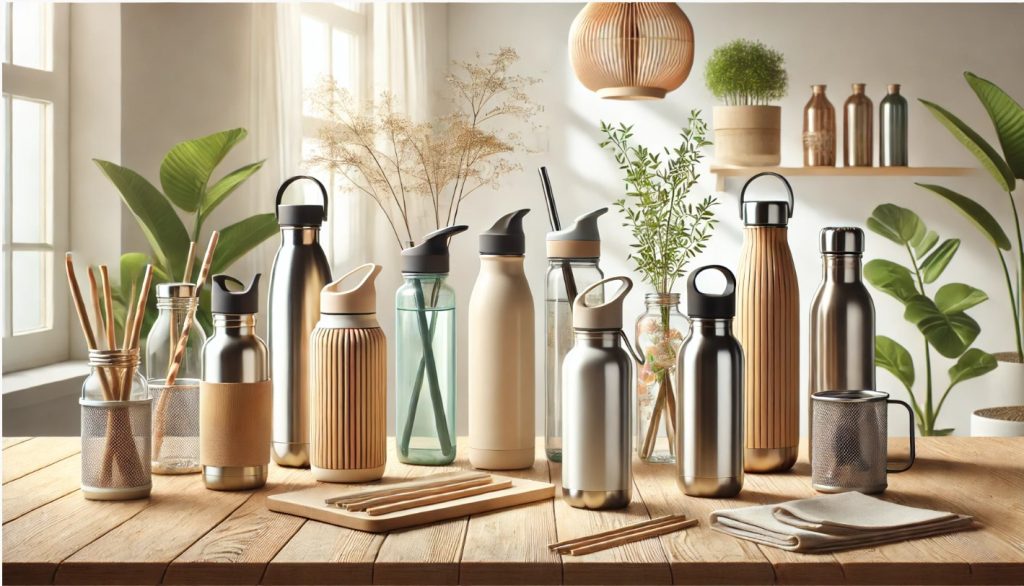Understanding Eco-Friendly Water Bottles
Eco-friendly water bottles represent a growing movement in consumer culture toward products that consider their environmental impact throughout their entire lifecycle. From the materials used in their construction to the processes involved in their production, eco-friendly water bottles aim to minimize harm to the planet while providing a practical, sustainable alternative to single-use plastic containers. They stand at the intersection of health, environmental stewardship, and personal convenience, offering a solution that is both responsible and appealing to the conscious consumer.
Over the past decade, heightened awareness of issues like plastic pollution, resource depletion, and climate change has prompted many people to reassess their daily habits. One significant shift has been away from single-use plastic bottles, which have dominated the beverage industry for generations. Instead, consumers are turning to more permanent, thoughtfully designed bottles that reduce waste, require fewer resources, and contain safer materials. Whether crafted from stainless steel, glass, bamboo, or recycled plastics, eco-friendly bottles reflect a broader cultural evolution toward more mindful consumption.
Why Eco-Friendly Bottles Matter
Reducing Single-Use Plastic Waste
The primary impetus behind eco-friendly water bottles is the dire need to reduce single-use plastic waste. Billions of disposable plastic bottles are manufactured, used, and discarded each year. Many of these end up in landfills, where they can take hundreds of years to break down, or in waterways, contributing to ocean pollution and harming wildlife. Each time someone opts for a reusable, eco-friendly bottle, they are effectively cutting down the demand for disposable plastics and mitigating a portion of the pollution problem.
Switching to an eco-friendly bottle can become part of a zero-waste lifestyle, aligning personal choices with larger environmental goals. Even one person using the same reusable bottle over several years can prevent hundreds or even thousands of single-use bottles from entering the waste stream. When multiplied across entire communities, this seemingly small change can have a substantial cumulative effect.
Conserving Resources
Manufacturing single-use plastic bottles consumes significant amounts of fossil fuels, water, and energy. By choosing a durable, eco-friendly alternative, consumers support a product that is meant to last, thus reducing the overall demand for virgin materials. Many eco-friendly bottles incorporate recycled metals or repurposed plastics, turning would-be waste into valuable products.
This conservation of resources is critical in a world facing limited supplies of natural materials and the ongoing degradation of ecosystems. While no product is entirely without environmental impact, eco-friendly bottles are designed to minimize negative effects, helping conserve precious resources for future generations.
Promoting Health and Safety
Eco-friendly water bottles often use materials that are less likely to leach harmful chemicals into beverages. This benefit is particularly relevant for individuals concerned about bisphenol A (BPA) and other potentially toxic compounds that may be found in lower-quality plastics. High-quality stainless steel and glass bottles are inert and do not introduce foreign substances into the liquids they hold. Bamboo and other plant-based materials are generally free of synthetic additives.
Beyond the health of the individual, there is a collective well-being dimension. The process of producing, transporting, and disposing of single-use plastics can release pollutants into the air, water, and soil, indirectly affecting human health. By choosing an eco-friendly bottle, one participates in a cycle that aims to reduce harmful emissions and protect community well-being.
Common Eco-Friendly Materials
Stainless Steel
Stainless steel is one of the most popular materials for eco-friendly bottles due to its durability, corrosion resistance, and recyclability. It can withstand frequent use, temperature changes, and accidental drops. While the initial production of stainless steel requires energy and resources, its longevity makes it a more sustainable choice over time. Stainless steel bottles do not retain flavors or odors, making them suitable for a variety of beverages. They also tend to have excellent insulation properties, keeping drinks cold or hot for longer periods.
Glass
Glass bottles are lauded for their purity. They are chemically inert, ensuring that no unwanted flavors or toxins leach into the beverage. Glass is also highly recyclable; it can be recycled indefinitely without losing quality. The main drawback of glass is its weight and fragility. Although tempered or borosilicate glass bottles are more durable than regular glass, they are still more breakable than stainless steel or certain plastics. Glass bottles are often favored by those who value a clean taste and a timeless aesthetic.
Bamboo and Other Plant-Based Materials
Bamboo and plant-based composites have emerged as sustainable options that capitalize on renewable resources. Bamboo grows quickly, requires fewer inputs than many crops, and can be harvested sustainably. Bottles incorporating bamboo might use it for exteriors, lids, or protective casings around other materials like stainless steel or glass. Plant-based plastics derived from corn, sugarcane, or other natural sources are also becoming more common. These bioplastics aim to reduce reliance on petrochemicals and may be compostable under the right conditions.
Recycled and Upcycled Plastics
While plastics are often associated with environmental harm, some eco-friendly bottles use recycled plastics to reduce the need for new raw materials. By giving a second life to plastic materials that might otherwise end up in landfills, these bottles help close the loop in a circular economy. Although concerns remain about the long-term safety and chemical stability of certain plastics, using high-quality, BPA-free, and phthalate-free recycled plastics can be a more responsible choice for those who prefer a lightweight, affordable, and shatter-resistant option.
Silicone
Silicone is sometimes incorporated into eco-friendly bottle design, particularly for lids, seals, and grips. Made from silica derived from sand, silicone is more heat-resistant and durable than many synthetic rubbers. It does not degrade into microplastics in the environment and can withstand years of use. While silicone is not always biodegradable, its long lifespan and non-toxic nature make it a suitable complement to other eco-friendly materials.
Key Features of Eco-Friendly Water Bottles
Durability and Longevity
An essential aspect of eco-friendly water bottles is their ability to stand the test of time. Durability is directly tied to environmental impact. A bottle that lasts for years prevents the need to produce new bottles and reduces the likelihood of waste ending up in landfills. Materials like stainless steel, borosilicate glass, and high-quality silicone are known for their robustness, making them ideal for long-term use.
Durability also aligns with personal convenience and cost-effectiveness. While some eco-friendly bottles may cost more upfront, their extended lifespans often result in savings over time. A well-made bottle that does not need frequent replacement is kinder to both the environment and the wallet.
Versatility and User-Friendliness
The best eco-friendly bottles are designed for everyday use, with features that make them practical and convenient. Some include leak-proof lids, built-in straws, or ergonomic handles. Others have wide-mouth openings that simplify cleaning and allow the addition of ice, fruit, or tea bags. Aesthetics also matter; a visually appealing design can encourage consistent use, further reducing waste.
Versatility extends to a bottle’s compatibility with various beverages. Many eco-friendly bottles can handle both hot and cold liquids, making them suitable for water, tea, coffee, smoothies, and more. The more versatile the bottle, the more likely it will remain in use, substituting multiple disposable containers throughout the day.
Responsible Manufacturing Practices
It is not enough for a bottle to be made from eco-friendly materials. True sustainability considers the entire supply chain, from raw material extraction to manufacturing, transportation, packaging, and end-of-life disposal. Companies that embrace environmental stewardship may use renewable energy in their factories, minimize waste during production, and reduce greenhouse gas emissions along their supply chains.
Some eco-friendly bottle brands practice ethical labor standards, ensuring that the people involved in making the product are treated fairly. When evaluating eco-friendly bottles, consumers can look for products that highlight transparency, certifications, or third-party verifications of their environmental and social claims.
Choosing the Right Eco-Friendly Bottle
Considering Your Lifestyle and Needs
Selecting the ideal eco-friendly water bottle depends on personal habits and preferences. For someone who commutes on foot, a lightweight and durable stainless steel bottle might be best. For a person who works in an office, a glass bottle that looks elegant on a desk may suit their needs. Outdoor enthusiasts might value a rugged design, carabiner attachments, or insulating sleeves that keep water cold in hot conditions.
Lifestyle also influences the bottle’s size and shape. Some bottles fit neatly into car cup holders, backpack pockets, or bike cages, while others might be too large or bulky. Before purchasing, consider when and where the bottle will be used most frequently, the types of beverages it will hold, and how often it will be cleaned.
Budget and Quality
Eco-friendly bottles range from very affordable options to high-end, premium designs. Although cheaper bottles can still be a step up from single-use plastic, investing in a well-made product often pays off in terms of durability and user satisfaction. High-quality bottles tend to maintain their appearance, performance, and safety over time, reducing the need to replace them. Ultimately, choosing a bottle that strikes a balance between cost, quality, and features is key.
Avoiding impulse buys and reading product descriptions, labels, and reviews can help ensure a good fit. Seeking out brands with established reputations for quality and sustainability can also be a helpful approach.
Aesthetic and Personal Expression
An eco-friendly water bottle can serve as an expression of personal values and style. With countless colors, patterns, and finishes available, individuals can choose a bottle that resonates with their personality. Sleek minimalism, vibrant patterns, or natural textures like bamboo can all convey different messages. Some people enjoy showcasing their environmental commitment, while others prefer a subtle approach. Selecting an attractive bottle also encourages consistent use, subtly reinforcing the habit of carrying it everywhere.
Certifications and Transparency
While no external links or specific certifications should be listed, it is worth noting that some eco-friendly water bottle producers opt for certifications related to materials, fair labor, or environmental management systems. Others offer detailed information about their supply chains, carbon footprints, or charitable giving. Consumers can research these aspects on the brand’s official channels or read reliable product descriptions. A transparent, ethical brand is often a sign that the product aligns with broader sustainability principles.
Maintaining and Extending the Life of Your Eco-Friendly Bottle
Routine Cleaning and Care
Proper maintenance is crucial for ensuring that an eco-friendly bottle remains safe and pleasant to use. Most bottles benefit from regular rinsing with warm, soapy water, especially after holding flavored or sugary beverages. A bottle brush can reach interior surfaces that might be difficult to clean otherwise. For deeper cleaning, a mixture of water and mild vinegar can help remove odors or stains, followed by thorough rinsing to ensure no lingering taste.
Many eco-friendly bottles are dishwasher-safe, but it is always best to confirm the manufacturer’s recommendations. Excessive heat or harsh detergents might compromise certain materials or finishes. By taking the time to clean and care for a bottle properly, the user ensures its longevity and reduces the risk of bacterial growth.
Avoiding Extreme Conditions
While stainless steel and glass bottles are robust, repeatedly exposing them to extreme conditions like prolonged direct sunlight, freezing temperatures, or boiling water can diminish their lifespan. If a bottle is designed for hot liquids, it should clearly state so, and the user should avoid pushing beyond these guidelines. Treating the bottle with respect—storing it in a cool place, avoiding unnecessary drops, and preventing scratches—extends its life and maintains its functionality.
Inspecting for Wear and Tear
Over time, even the most durable eco-friendly bottle may show signs of wear, such as small dents, chips, or thinning silicone seals. Inspecting these features periodically can help catch potential issues before they become major problems. Replacing a silicone seal or a damaged lid, if possible, can give the bottle a second life rather than discarding it entirely. Responsible manufacturers often offer spare parts or warranty services, ensuring that the bottle remains functional for as long as possible.
End-of-Life Considerations
Recycling and Upcycling
An eco-friendly bottle’s journey does not necessarily end when it is no longer usable. Many materials, such as stainless steel and glass, are fully recyclable, provided they are processed through the correct facilities. Recycling recovers valuable materials and keeps them in circulation, reducing the need for new resources. Before recycling, make sure any non-recyclable components, like silicone grips or rubber seals, are removed if required by local guidelines.
Upcycling is another creative approach. A chipped glass bottle might become a flower vase, a stainless steel bottle could be repurposed as a kitchen utensil holder, and plastic components might find a second life in art projects. This ingenuity not only prevents waste but also encourages a more resourceful mindset.
Composting and Biodegradable Options
Some bottles incorporate biodegradable or compostable elements. Plant-based plastics, bamboo components, or certain silicone alternatives may break down under the right industrial composting conditions. While this is a relatively new area and depends heavily on local composting facilities, it underscores the growing emphasis on designing products that return to the earth without leaving permanent waste behind.
Before disposing of a bottle, it is prudent to check local waste management guidelines. Composting facilities, recycling centers, and community exchange programs can ensure that the bottle’s end-of-life phase aligns with the principles of circularity and environmental stewardship.
Environmental and Social Impact
Supporting Ethical Brands
Choosing an eco-friendly bottle often means supporting companies that have made conscious decisions about their materials, labor, and community engagement. Some brands donate a portion of their profits to environmental causes, support local artisans, or invest in sustainability research and innovation. By selecting such products, consumers help fund activities that go beyond personal utility, contributing to a broader movement toward ethical and regenerative business practices.
Empowering Consumer Voices
Consumers wield significant power in shaping market trends. As demand for eco-friendly bottles rises, manufacturers respond by improving their practices and innovating more sustainable materials. Over time, these collective choices can influence industry standards, encouraging more brands to adopt eco-friendly strategies and phasing out products that cause harm.
This democratization of influence means that buying an eco-friendly bottle is more than a personal choice; it is a vote for a healthier planet. By sharing experiences and recommending products to friends and family, consumers can help spur a ripple effect that leads to widespread environmental benefits.
Common Myths and Misconceptions
Eco-Friendly Always Means More Expensive
A common misconception is that eco-friendly products, including water bottles, are always more expensive. While some high-end brands carry premium pricing, there are also affordable options that maintain good quality and sustainability standards. Additionally, the long-term savings from avoiding disposable bottles can quickly offset any initial cost differences. When considering total cost of ownership and environmental impact, eco-friendly bottles often prove to be a more economical and responsible choice over time.
Sustainable Means Indestructible
No product is truly indestructible, and eco-friendly bottles are no exception. While they are designed to be long-lasting, they still require proper care and handling. Treating an eco-friendly bottle responsibly is a partnership between the manufacturer and the user. Durability is a key feature, but it does not mean one can neglect maintenance or subject the bottle to misuse.
One Bottle Makes No Difference
It is easy to assume that individual actions have little impact, but this viewpoint underestimates the power of collective effort. One person’s decision to use a reusable bottle instead of disposable plastics prevents multiple bottles from entering the waste stream. When multiplied by hundreds, thousands, or millions of people, the positive effect becomes substantial. Social change often begins with individual choices, building momentum as more people adopt similar habits.
Integrating Eco-Friendly Bottles into Everyday Life
Commuting and Traveling
Eco-friendly bottles are ideal companions for daily commutes, long road trips, or flights. Their durable construction reduces the fear of breakage, and many are designed to fit into car cup holders and backpack compartments. Carrying a reusable bottle ensures that one can stay hydrated without resorting to single-use plastic bottles from convenience stores or airports. Over time, such consistency reduces environmental impact and can serve as a conversation starter about sustainability with fellow travelers.
Office and School Environments
Bringing an eco-friendly bottle to work or school is a simple way to reduce waste generated by vending machines or cafeterias. Some workplaces encourage employees to bring their own bottles, and schools may discourage single-use plastics as part of their sustainability efforts. Keeping a bottle at one’s desk not only reduces waste but also encourages regular hydration, which is beneficial for health and productivity.
Exercise and Outdoor Activities
Whether running, cycling, hiking, or practicing yoga, an eco-friendly bottle can withstand the demands of an active lifestyle. Insulated options keep water cold during intense workouts, while secure lids prevent leaks in backpacks or gym bags. Outdoor enthusiasts appreciate bottles that can handle bumps, drops, and exposure to the elements without losing their structural integrity or contaminating the environment.
Social and Cultural Shift
Carrying an eco-friendly bottle is becoming a cultural norm in many places, symbolizing environmental awareness and personal responsibility. As more people embrace these products, it becomes easier for others to follow suit. Over time, this normalization of sustainable habits transforms consumer culture, making the default choice more environmentally friendly and reducing the stigma that sometimes surrounds green consumerism.
Future Trends and Innovations
Advanced Materials and Technologies
As technology advances, so do the possibilities for more sustainable materials. Researchers are experimenting with new bioplastics, algae-based polymers, and materials derived from agricultural waste. As these innovations enter the marketplace, eco-friendly bottles may become even more biodegradable, durable, and cost-effective. Continuous improvement in production techniques could lower energy consumption, reduce greenhouse gas emissions, and streamline the recycling process.
Modular and Repairable Designs
The future may see more eco-friendly bottles with modular components. Interchangeable lids, silicone sleeves, or filters can allow users to customize their bottles for different activities while extending their lifespans. If a part wears out, it can be replaced without discarding the entire bottle. This modular approach encourages long-term use, reduces resource consumption, and helps combat the built-in obsolescence that plagues many modern consumer goods.
Integration with Smart Devices
Some forward-thinking brands are exploring the integration of smart technology, such as sensors that track water intake, remind users to hydrate, or even purify the water using built-in UV technology. While not all of these features are necessary or universally desired, they represent the intersection of sustainability, health, and innovation. Smart eco-friendly bottles can help people become more conscious of their hydration habits while staying firmly rooted in environmental responsibility.
Overcoming Challenges and Barriers
Education and Awareness
One major challenge in expanding the use of eco-friendly water bottles is the need for education. Many people remain unaware of the severity of plastic pollution or the numerous benefits of reusable alternatives. Raising awareness through community workshops, environmental campaigns, or social media initiatives can help bridge the knowledge gap. When people understand the reasons behind using eco-friendly bottles, they are more likely to embrace them wholeheartedly.
Affordability and Accessibility
While the market now offers a wide range of eco-friendly bottles, ensuring affordability and accessibility remains an ongoing task. Some communities may have limited access to quality options, while others may struggle with the upfront cost. Brands that find ways to reduce manufacturing costs without compromising quality, or organizations that sponsor local bottle distribution programs, can help bring sustainable solutions to more people.
Cultural Norms and Resistance to Change
Human habits are deeply ingrained, and altering them can be challenging. Some individuals may resist switching from single-use bottles, citing convenience or skepticism about the difference one product can make. Overcoming this resistance often involves showing success stories, providing clear examples of environmental benefits, and making eco-friendly bottles as user-friendly as possible. Peer influence and community support can also encourage reluctant individuals to take the first step.







